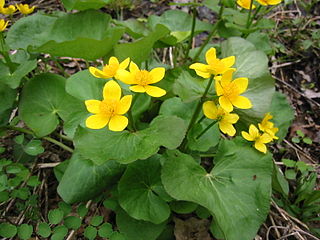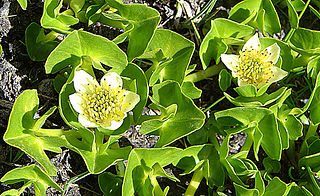
The Venus flytrap is a carnivorous plant native to the temperate and subtropical wetlands of North Carolina and South Carolina, on the East Coast of the United States. Although various modern hybrids have been created in cultivation, D. muscipula is the only species of the monotypic genus Dionaea. It is closely related to the waterwheel plant and the cosmopolitan sundews (Drosera), all of which belong to the family Droseraceae. Dionaea catches its prey—chiefly insects and arachnids—with a "jaw"-like clamping structure, which is formed by the terminal portion of each of the plant's leaves; when an insect makes contact with the open leaves, vibrations from the prey's movements ultimately trigger the "jaws" to shut via tiny hairs on their inner surfaces. Additionally, when an insect or spider touches one of these hairs, the trap prepares to close, only fully enclosing the prey if a second hair is contacted within (approximately) twenty seconds of the first contact. Triggers may occur as quickly as 1⁄10 of a second from initial contact.

Adonis is a genus of about 20–30 species of flowering plants of the crowfoot family, Ranunculaceae, native to Europe and Asia.

Caltha is a genus of rhizomatous perennial flowering plants in the family Ranunculaceae, to which ten species have been assigned. They occur in moist environments in temperate and cold regions of both the Northern and Southern Hemispheres. Their leaves are generally heart-shaped or kidney-shaped, or are characteristically diplophyllous. Flowers are star shaped and mostly yellow to white. True petals and nectaries are missing but the five or more sepals are distinctly colored. As usual in the buttercup family there is a circle of stamens around free carpels.

Cornus canadensis is a species of flowering plant in the dogwood family Cornaceae, native to eastern Asia and North America. Common names include Canadian dwarf cornel, Canadian bunchberry, quatre-temps, crackerberry, and creeping dogwood. Unlike its relatives, which are for the most part substantial trees and shrubs, C. canadensis is a creeping, rhizomatous perennial growing to about 20 centimetres tall.

Grayia is a genus of plants in the subfamily Chenopodioideae of the family Amaranthaceae. Common names are siltbush and hopsage. The four shrubby species occur in arid and semiarid regions of western North America:

Caltha leptosepala, the white marsh marigold, twinflowered marsh marigold, or broadleaved marsh marigold, is a North American species of flowering plant in the buttercup family. The species has regionally distinct variations.

Pinguicula orchidioides is a perennial rosette-forming insectivorous herb native to Mexico and Guatemala. A species of butterwort, it forms summer rosettes of flat, succulent leaves up to 5 centimeters (2 in) long, which are covered in mucilaginous (sticky) glands that attract, trap, and digest arthropod prey. Nutrients derived from the prey are used to supplement the nutrient-poor substrate that the plant grows in. Uniquely among Pinguicula species from the Americas, p. orchidioides produces gemma-like basal buds which elongate into stolons and serve as a means of asexual reproduction. In the winter the plant forms a non-carnivorous rosette of small, fleshy leaves that conserves energy while food and moisture supplies are low. Single purple flowers appear between July and September on upright stalks up to 22 centimeters long.

Brunfelsia latifolia, commonly known as yesterday-today-tomorrow and kiss me quick, is a species of flowering plant in the nightshade family. Endemic to Brazil, it is an evergreen shrub that becomes semi-deciduous in cooler areas and grows up to 1.8 meters in height.

Solanum evolvuloides is a species of Solanum, which was first described in 2011 by Giacomin & Stehmann. Solanum evolvuloides belongs to section Gonatotrichum, a small group assigned to the Brevantherum clade of the genus Solanum. It resembles Solanum turneroides Chodat, sharing with it heterandry, and Solanum parcistrigosum Bitter, with which it shares a similar habit and pubescence. Despite these similarities, the species can be recognized by its ovate-elliptic to cordiform leaf shape and more membranaceous leaf texture than the other species in the section, and stem, inflorescence axes, and calyx vestiture mainly composed of glandular hairs. Solanum evolvuloides is known to occur only in southeastern of Bahia state, Brazil, and in a preliminary assessment of the International Union for Conservation of Nature (IUCN) criteria can be considered a threatened species.
Drosera peruensis is a carnivorous plant of the genus Drosera, commonly known as the Peruvian sundew. This Drosera species was first identified in Peru in 2002 by Tânia Regina dos Santos Silva and Mireya D. Correa following work to update the genus Drosera for the reference text, Flora Neotropica..

Caltha appendiculata is a perennial herb plant found in several countries of South America.

Caltha sagittata is a low to medium height, rhizomatomous perennial herb with ivory hermaphrodite flowers, belonging to the Buttercup family. It grows in clusters in sunny wet places in the Andes and related mountain chains. It has a disjunct distribution concentrated in the Southern Cone of South America.

Caltha novae-zelandiae, commonly known as New Zealand marsh marigold or yellow caltha, is a small, perennial herbaceous plant belonging to the family Ranunculaceae, that grows in open vegetations in mountainous areas, and is endemic to New Zealand.

Caltha obtusa; commonly known as white caltha; is a small, perennial herbaceous plant belonging to the family Ranunculaceae, that grows in open vegetations in mountainous areas, and is endemic to New Zealand's South Island.

Caltha introloba, commonly known as the alpine marsh-marigold is a small hairless, perennial alpine herb, that is endemic to the alpine regions of Australia and Tasmania.
Caltha scaposa is a low, perennial herb with one or two yellow hermaphrodite saucer-shaped flowers. This marsh-marigold species belongs to the buttercup family, grows in moist alpine fields and is native to the eastern Himalayas and the mountains on the eastern margin of the Tibetan highland.

Plantago aucklandica is a species of flowering plant in the family Plantaginaceae that is endemic to the subantarctic Auckland Islands, New Zealand. Joseph Dalton Hooker described P. aucklandica in his Flora Antarctica in 1844. Plants of this plantain are large with large leaves, up to seven veins, wide petioles, colliculate seeds, and long spikes with dozens of flowers and one-seeded fruits. This species in considered to be At Risk - Naturally Uncommon, as it is an island endemic with a restricted range.
Hoffmannanthus is a monotypic genus of flowering plants in the Asteraceae. There is only one known species, Hoffmannanthus abbotianus(O.Hoffm.) H.Rob., S.C.Keeley & Skvarla Its native range is Uganda and southern Tropical Africa. It is found in the countries of Angola, Kenya, Tanzania, Uganda, Zambia and Zaïre.

Myosotis albiflora is a species of flowering plant in the family Boraginaceae, native to southern Chile and Argentina. This species was described by Joseph Banks and Daniel Solander in Joseph Dalton Hooker's 19th century work Flora Antarctica. Plants of this species of forget-me-not are perennial and have white corollas. It is one of two native species of Myosotis in southern South America, the other being M. antarctica.

Ourisia macrocarpa or snowy mountain foxglove is a species of flowering plant in the family Plantaginaceae that is endemic to the South Island of New Zealand. Joseph Dalton Hooker described O. macrocarpa in 1853. Plants of this species of New Zealand foxglove are showy, perennial, large-leaved, tufted, rhizomatous herbs that are mostly glabrous (hairless) or with some non-glandular hairs. They have broadly ovate leaves. The flowers are in whorls in each node, with an irregular calyx, a large, white irregular corolla, and fruits up to 1 cm long. The corolla tube is yellow with three lines of yellow hairs inside. It is listed as Not Threatened.


















